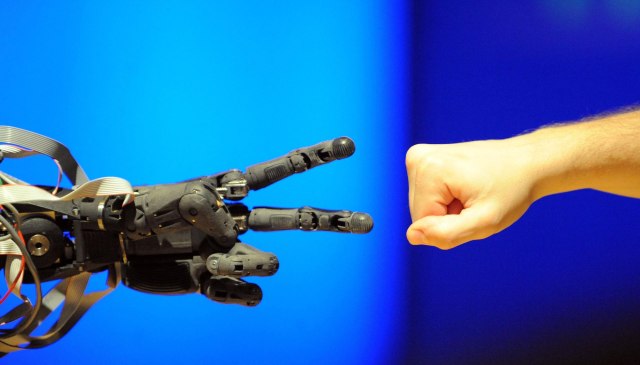Rock, paper, scissors with Berti the robot at the Science Museum in London. Ian Nicholson/PA Archive/PA Images

Hello reader, are you trans? Transhuman, that is.
Probably not, but one day you might be – or, failing that, your kids or grandkids. In what is very much a ‘guest’ piece for the American Conservative, Zoltan Istvan – the Libertarian candidate for Governor of California – explains his transhumanist vision:
“…transhumanism is the international movement of using science and technology to radically change the human being and experience. Its primary goal is to deliver and embrace a utopian techno-optimistic world—a world that consists of biohackers, cyborgists, roboticists, life extension advocates, cryonicists, Singularitarians, and other science-devoted people.”
There’s no need to fear a robot taking your job – not if you become one yourself!
Seriously though, Istvan makes a good point when he says that the technology is already redefining our humanity:
“So why are so many people jumping on the transhumanist bandwagon? I think it has to do with the mishmash of tech inundating and dominating our daily lives. Everything from our smartphone addictions to flying at 30,000 feet in jet airplanes to Roombas freaking out our pets in our homes. Nothing is like it was for our forbearers. In fact, little is like it was even a generation ago. And the near future will be many times more dramatic: driverless cars, robotic hearts, virtual reality sex, and telepathy via mind-reading headsets. Each of these technologies is already here, and in some cases being marketed to billions of people. The world is shifting under our feet—and libertarian transhumanism is a sure way to navigate the chaos to make sure we arrive at the best future possible.”
As a conservative cishumanist, I very much doubt that there’s anything “sure” about libertarian transhumanism (and for a corrective to Istvan’s boundless optimism read this response from Kai Weiss, also in the American Conservative). Nevertheless, I think its worth examining the transhumanist argument on its own terms.
For instance, Istvan’s account of transhumanism’s core motivation:
“The future is coming fast, people around the world are realizing, and there’s no denying that the transhumanist age fascinates tens of millions of people as they wonder where the species might go and what health benefits it might mean for society.
“At the end of the day, transhumanism is still really focused on one thing: satisfying that essential addiction to curiosity.”
Not withstanding the fate of the proverbial cat, I’m all for curiosity. I also accept that this is what makes transhumanism tick (thus far). But if the movement is to extend beyond its early adopters then it will have to satisfy other, more basic, motivations. Take self-preservation for instance:
“With science, technology, and a liberty-minded outlook as our tools, the species can seek out and even challenge the very nature of its being and place in the universe. That might mean the end of human death by mid-century if governments allow the science and medicine to develop.”
The word “might” is doing an awful lot of work in that last sentence. Though technology does have the potential to change our societies in some pretty fundamental ways, it also moves much more slowly than we sometimes imagine. It’s not government regulation, medical ethics or religious doctrine that’s holding up the march of transhumanism, but the size of the scientific challenge of, say, extending our natural life-spans.
In all probability we won’t have immortality in our time – not because of red-tape, but because overcoming death is just too difficult.
After all, we’re only human.










Join the discussion
Join like minded readers that support our journalism by becoming a paid subscriber
To join the discussion in the comments, become a paid subscriber.
Join like minded readers that support our journalism, read unlimited articles and enjoy other subscriber-only benefits.
Subscribe